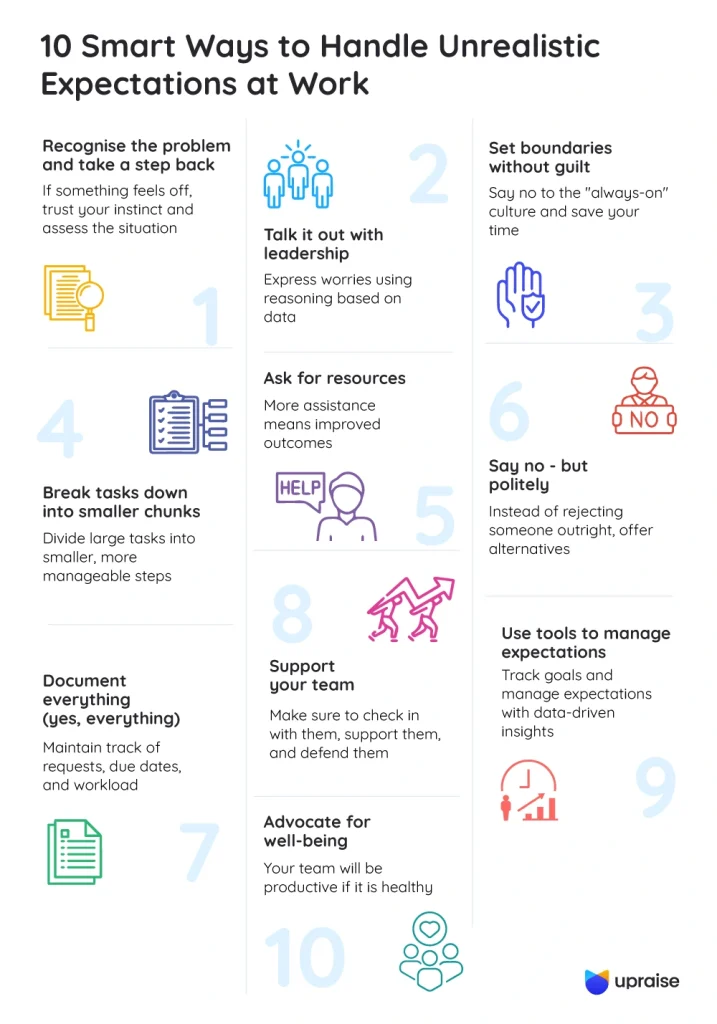Unrealistic expectations at work have become a significant concern for employees and managers. It is the latter’s responsibility to strike a balance between driving performance and avoiding unreasonable standards.
A 2021 survey by the American Psychological Association revealed that 59% of employees have experienced negative impacts of work-related stress, including lack of interest, motivation, or energy.
Managers must recognize how unrealistic expectations can affect their teams and implement strategies that promote a healthier, more productive workplace.
In this article, let’s look at unrealistic expectations at work – what they look like, what are the practical strategies to tackle them, and, most importantly, how to handle the impact of unreasonable workloads on employees.
What are some unrealistic expectations at work?
Unrealistic expectations at work often arise from a disconnect between leadership’s vision and employees’ capacity to deliver. These expectations can lead to dissatisfaction, burnout and a decline in productivity. Here are some common instances:
1. Unachievable deadlines
Your team is handed a project that usually takes six weeks to complete, but leadership insists it must be done in two. The result? Overtime hours, rushed decisions, and burnt-out employees.
Example: A marketing team is tasked with launching a product campaign within ten days despite needing time for market research. The quality suffers, and the team feels undervalued.
2. Expecting employees to always be available
With remote and hybrid work on the rise, the line between work and personal life has blurred. Constant messages and emails outside of working hours create an unsustainable “always-on” culture.
Example: A manager emails a direct report at midnight, expecting an immediate response. This “always-on” culture creates the perception of an unreasonable workload.
3. Demanding perfection at all times
Perfectionism can paralyze teams and cause delays. While quality work is essential, expecting flawless results for every task is impractical.
Example: A design team spends endless hours revising a campaign because leadership keeps asking for “just one more tweak.” The project misses its launch date, and the team feels demoralized.
4. Heavy workloads without additional support
When employees are given responsibilities far beyond their capacity without added resources, burnout becomes inevitable.
Example: An HR manager is expected to oversee recruitment, payroll, compliance and employee engagement alone. Such unachievable goals and their impact on employees are evident as tasks fall through the cracks.
5. Ignoring individual limitations
Every employee has a different learning curve and skill set. Ignoring this reality and setting unachievable goals for everyone creates a toxic work environment.
Example: A new intern is assigned KPIs that match those of a seasoned manager. This results in feelings of failure and reduces their confidence to perform.
All in all, minimizing the impact of unrealistic expectations in the workplace requires a specific skill set. We will discuss this in more detail below.
How to handle unrealistic expectations at work?
Managing unrealistic expectations at work is no walk in the park. You want to deliver results without running your team aground, but when the demands feel impossible, something’s got to give. Here’s a step-by-step approach to handle unrealistic expectations:

1. Recognize the problem and take a step back
The first step is simple: admit there’s a problem. If something feels off, trust your gut. Are deadlines too tight? Is the workload unreasonable? Identifying the issue is half the battle.
2. Talk it out with leadership
Open and honest communication is your best tool. Sit down with decision-makers and explain why these unrealistic standards won’t work. Use real examples or data to back up your point.
3. Set boundaries without guilt
It’s necessary to set personal and professional boundaries. Let your team know it’s fine to unplug after work hours. Don’t encourage an “always-on” culture. Otherwise, you’re inviting burnout through overwork.
4. Break tasks down into smaller chunks
Unrealistic goals often feel overwhelming because they’re just too big. Split those massive projects into bite-sized tasks, prioritize them and focus on one piece at a time. This way, the goal feels more attainable.
5. Ask for resources
Sometimes, the issue isn’t the task itself but the lack of resources to get it done. Don’t hesitate to ask for help – be it more team members, extra budget, or even an extended timeline. Highlight how this revised resource allocation will improve the outcome.
6. Say no – but politely
Pushing back can feel uncomfortable, but it’s essential. Explain why certain demands aren’t achievable and propose an alternative. This isn’t about defiance; it’s about delivering results that actually work.
7. Document everything (yes, everything)
Keep a record of your assignments, deadlines and decisions. If you’re dealing with unrealistic expectations and need to provide examples, you’ll want to have written proof of what was asked versus what’s feasible. It’s your safety net.
8. Support your team
Check-in regularly with your team. Ask them how they’re doing and what’s blocking their progress. Show that you’ve got their back. When they know you’re on their side, they’ll trust you even during tough times.
9. Use tools to manage expectations
Tailormade tools are lifesavers when dealing with complex tasks or unrealistic goals. One such standout solution is UpRaise app for Employee Success, which integrates effortlessly with Jira to offer a complete performance management system. UpRaise lets you monitor goals, provide instant feedback, and adjust expectations based on actual data, not guesswork.
10. Advocate for well-being
Don’t just focus on tasks; focus on people. Whether it’s setting up wellness programs, encouraging mental health days, or offering flexibility, make sure your team feels supported. Happy employees deliver better results—every time.
Setting the stage: why do unrealistic expectations happen?
Unrealistic expectations at work aren’t always born out of bad intentions. Sure, some managers might push too hard, but these expectations often stem from miscommunication or a lack of clarity.
Think back to the best manager you’ve worked with. Chances are, they encouraged open dialogue and made you feel comfortable sharing when a task felt overwhelming. Transparency is crucial for avoiding unrealistic standards, yet many managers fail to create this kind of workplace culture.
But why does this happen?
- Managers sometimes push too hard due to pressure to deliver results quickly
- A lack of open dialogue between managers and employees creates a gap, making it hard to address unrealistic standards.
- Ignoring employee input often leads to unreasonable workloads.
- Without collaboration and planning, unrealistic expectations can cause missed deadlines.
Conclusion
Handling unrealistic expectations at work is about open communication, setting clear boundaries and offering practical solutions. By staying proactive and supportive, you can understand and address unrealistic expectations and create a workplace where goals feel challenging yet achievable.
FAQs
Q1. How to let go of unrealistic expectations?
Start by recognizing what’s beyond your control. Focus on actionable goals, set realistic timelines and prioritize communication to avoid being burdened by unrealistic standards.
Q2. How can unrealistic expectations cause stress?
They lead to constant pressure, overwork and an unreasonable workload, which can negatively impact mental health and productivity.
Q3. How to stop having unrealistic expectations?
Understand your limitations, plan realistically and communicate openly. Adjust your mindset to focus on progress rather than perfection.
Q4. How to tell your boss their expectations are unrealistic?
Respectfully present an action plan or timeline. Use data or examples to explain why the task is challenging and offer practical alternatives that align with workplace goals.

